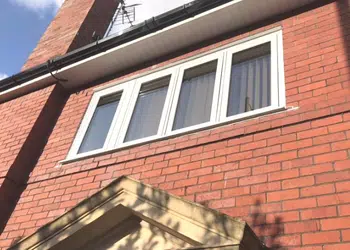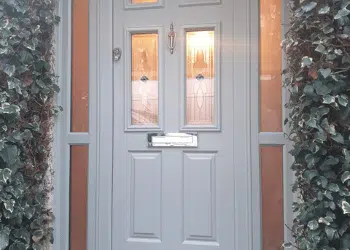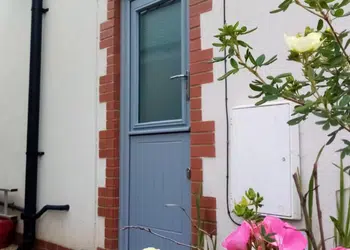Upgrade Your Home with Confidence: A Guide to Choosing Replacement Windows
As a homeowner, replacement windows are one of the most rewarding investments you can make. They’re not just panes of glass that keep the elements out; they’re vital components for energy efficiency, security, and the aesthetic appeal of your home.
With so many options on the market, how do you choose the right replacement windows that align with your needs and preferences? This article will guide you through the essential considerations for selecting replacement windows that will transform your living space and reduce energy costs.

Materials: UPVC, Aluminium, or Timber?
When choosing replacement windows, homeowners are faced with selecting the most suitable material for their needs and preferences, with uPVC, aluminium, and timber being the primary options.
uPVC windows are popular for their affordability, low maintenance requirements, and excellent insulation properties, making them energy-efficient and cost-effective in the long run.
On the other hand, aluminium windows offer sleek, modern aesthetics and durability, with slim frames allowing for larger glass areas and unobstructed views. They are highly corrosion-resistant and require minimal maintenance, ideal for contemporary homes seeking a minimalist look and robust performance.
Timber windows, while often pricier than uPVC and aluminium, provide timeless charm and natural warmth, enhancing the character and authenticity of traditional and period properties. With proper maintenance, timber windows can last for decades and be easily customised to match the home’s architectural style.
Ultimately, the choice between uPVC, aluminium, and timber replacement windows depends on factors such as budget, aesthetics, energy efficiency, and architectural compatibility, with each material offering distinct advantages to meet homeowners’ specific needs and preferences.

UPVC – The Cost-Effective, Low-Maintenance Champion
Unplasticised Polyvinyl Chloride, or UPVC, is a popular choice among homeowners for its affordability and ease of maintenance. UPVC windows are resistant to rot and do not require painting or sealing, making them an excellent option for those looking for longevity without the upkeep.
Aluminium – The Sleek, Modern Contender
Aluminium windows are renowned for their strength, which allows for slimmer frames and more glass. They’re perfect for a modern aesthetic and are highly durable against the elements. Although typically more expensive than UPVC, they offer a unique look and great longevity.
Timber – The Timeless Classic
For those seeking natural beauty, timber windows offer unparalleled warmth and style. They’re great for preserving the character of traditional homes and can be real assets in conservation areas. While they require more maintenance than their UPVC and aluminium counterparts, their lifetime value and eco-friendly credentials can be worth the investment.

Glazing Options: Double or Triple?
When considering replacement windows, one important decision homeowners face is whether to opt for double glazing or triple glazing for their windows. Both options offer advantages regarding energy efficiency, sound insulation, and overall comfort, but understanding their differences is crucial for making an informed choice.
Double glazing consists of two panes of glass separated by a layer of air or inert gas, providing insulation against heat loss and noise. On the other hand, triple glazing adds an additional pane of glass, offering even greater thermal efficiency and soundproofing benefits. However, triple glazing tends to be more expensive upfront, and the increased weight may require sturdier window frames.
Factors such as climate, budget, and specific requirements for noise reduction or energy efficiency should all be considered when deciding between double and triple glazing for replacement windows.
Double Glazed – The Standard in Insulation
Double glazing consists of two glass panes with a gap in between, usually filled with an inert gas, which provides adequate insulation for most homes. Double-glazed windows are a minimum for energy efficiency and sound reduction. If you can’t achieve double glazing because of planning restrictions consider secondary glazing.
Triple Glazed – For Maximum Energy Efficiency
For climates with harsher weather or for those looking to push their home’s energy efficiency to the limit, triple glazing offers an additional layer of protection. While more expensive, the benefits of extra insulation and soundproofing can make a significant difference.

Style Statements with Colour
Classic White or Bold Colours?
Replacing your windows is a chance to rethink the colour scheme of your façade. While classic white remains a popular choice for its versatility, you can consider other colour options to make a statement or complement your home’s brickwork. Today’s quality windows come in a spectrum of colours, ensuring there’s one to suit every style.
Grey Windows
Grey windows have emerged as a stylish and contemporary option for homeowners seeking to enhance the aesthetic appeal of their properties. Particularly popular for aluminium window frames, grey frames offer a sleek and modern look that complements various architectural styles, from minimalist to industrial. The neutral tone of grey windows adds sophistication to modern and traditional homes, providing a subtle yet striking contrast against exterior facades.
While white windows remain the top choice for uPVC frames, grey has steadily gained traction as the second most preferred colour option due to its versatility and ability to blend with different design schemes effortlessly.
Whether used as a bold statement or as a subtle accent, grey windows exude a sense of understated elegance and refinement, making them a desirable choice for homeowners seeking to elevate the appearance of their homes while maintaining a timeless aesthetic.

Styles to Suit Your Lifestyle
Casement, Sliding Sash, or Tilt and Turn?
The style of your windows should marry form and function. Casement windows offer a traditional look while sliding sash windows might fit a period property. Tilt and turn windows offer practicality for cleaning and ventilation, proving especially useful in multi-storey buildings.
Casement Windows
Casement windows remain the most popular choice for homeowners seeking functionality and aesthetic appeal. Their simple yet elegant design features a single sash hinged at the side and opens outward with the help of a crank mechanism, allowing for smooth operation and excellent ventilation control.
Casement windows provide ample natural light and unobstructed views of the outdoors, making them ideal for maximising daylight and creating a sense of openness within a space. Additionally, when closed, their airtight seal offers superior energy efficiency, helping maintain comfortable indoor temperatures and reducing heating and cooling costs.
Available in various materials, finishes, and configurations, casement windows can be customised to complement any architectural style while adding character and charm to any home. Whether used individually or grouped to create a stunning focal point, casement windows offer timeless beauty, versatility, and practicality for homeowners seeking both form and function in their window choices.

Tilt and Turn Windows
Tilt and turn windows are an innovative and versatile option combining functionality with modern design. These windows feature a unique dual-opening mechanism that allows them to tilt inwards from the top for ventilation or swing open like a casement window from the side for easy cleaning and maximum airflow.
This dual functionality allows homeowners to control ventilation, security, and cleaning accessibility. Tilt and turn windows are known for their excellent insulation properties, offering a tight seal when closed to enhance energy efficiency and reduce noise transmission. Their sleek and contemporary appearance makes them suitable for various architectural styles, adding aesthetic appeal and practicality to any home.
With their ease of operation, superior performance, and stylish design, tilt-and-turn windows offer a smart and functional solution for homeowners seeking convenience, comfort, and modern sophistication in their window choices.

Sliding Sash Windows
Sash windows are a timeless and elegant choice for homeowners looking to add character and charm to their property. Characterised by their vertical sliding design, sash windows have two moveable panels or sashes that can be opened from the top and bottom.
The unique design of sash windows allows for flexible ventilation options, enabling homeowners to control airflow while maintaining security and privacy. Sash windows are renowned for their classic aesthetic appeal and can enhance the architectural style of both traditional and contemporary homes. Their slender frames and large glass panes maximise natural light, creating bright and inviting living spaces. Additionally, sash windows are often crafted from high-quality materials and can be customised to suit individual preferences, ensuring durability and visual appeal. With their timeless elegance and practical functionality, sash windows remain a popular choice for homeowners seeking to elevate the beauty and functionality of their homes.

Window Configuration
Window configuration refers to the arrangement and layout of windows within a building’s facade or interior space. Designing the best windows for your home includes considerations such as the size, shape, style, and placement of windows to optimise natural light, views, ventilation, and aesthetic appeal.
The configuration of windows can significantly impact the overall design and functionality of a home or commercial building, influencing factors like energy efficiency, indoor comfort, and visual harmony.
Whether selecting traditional double-hung windows, contemporary casement windows, or expansive floor-to-ceiling glass walls, choosing the right window configuration is essential for creating a comfortable, inviting, and visually pleasing environment.
Architects and homeowners often collaborate to design window configurations that suit the building’s specific needs, preferences, and architectural style, ensuring that each window serves both practical and aesthetic purposes effectively.
Same House – Different Windows
When several houses are built together such as along a road or in an estate, they are usually built with some uniformity. This makes sense from an aesthetic point of view as well as financial. It is always cheaper and quicker to build several of the same design rather than individual.
This uniformity usually remains the same until the first house is sold and new people move in. If by this time, the windows are outdated and less efficient, it makes sense that they will be upgraded and at the same time, the homeowner will put their own stamp on their home.
Quite often, the front door is the first change as the entrance can reflect the personality of the homeowner.
In the three pairs of semi detached windows below, you can see that they have all chosen different configurations. One has chosen Georgian bars and no top lights. Top lights are the small opening windows. All have divided the large top window into thirds but some have opted for three panes and the others have chosen a casement window equal to a third of the width and one larger window.
WHich one do you think looks best?



Time for Change
Homeowners often don’t realise they have a choice. The first instinct is to choose the same configuration as the existing one. However, this is an opportunity to make significant changes. For example, the current window might not provide enough natural light or adequate ventilation. Fashions change, even in windows, so the current configuration may not suit your vision of your home.
Don’t be afraid to explore different options and configurations when selecting new windows. Consider factors like energy efficiency, functionality, aesthetics, and personal preferences.
Do you have windows you never open because you can’t reach them?
If you have a window over the sink, would it be better to reach it more easily as a top-hung window?
Is there a walkway by your window which affects safety or security?
Can you wash your windows easily, or would tilt and turn be a better option?
Is there a window that would work better as a set of French doors?
Do you have enough light coming in, or is there an area where large glazing might work, such as in a hallway?
Do You Have to Follow the Neighbours?
When choosing windows for a property, there isn’t necessarily a requirement to match the choices of neighbouring properties.
While maintaining architectural harmony within a neighbourhood can contribute to a cohesive streetscape, individual homeowners can select window styles, materials, and configurations that best suit their preferences, needs, and budget.
Factors such as the home’s architectural style, personal taste, and desired functionality should guide the decision-making process. However, it’s essential to consider local planning regulations, homeowners’ association rules, and the overall aesthetic context of the neighbourhood when making window selections.
While mimicking the choices of neighbouring properties can create a unified appearance, embracing individuality through unique window designs can also contribute to the character and diversity of the community.
Ultimately, homeowners should prioritise their own preferences and needs while being mindful of the broader context and regulations governing their property.
Experienced Advice and Installation
We can help you explore the options. Our friendly experts will help you every step of the way.
Choosing the right replacement windows involves experts who can tailor their advice to your specific circumstances. Consider arranging a consultation to discuss which features best fit your home’s architecture and daily needs. Remember: skilled installation is as important as the quality of your windows, so ensure you employ reputable professionals.
Conclusion – Balance Aesthetics with Functionality
Replacement windows are an important architectural and energy component of your home. By considering materials, glazing, colour, and configuration, you can ensure that your new windows blend form and function perfectly. They’re not just replacements; they’re upgrades that add value in multiple ways.
Remember, your satisfaction is the top priority. With the right choices to make your home pleasant and efficient, rest easy knowing that your investment in replacement windows is sound for your comfort and the future of your home.
























